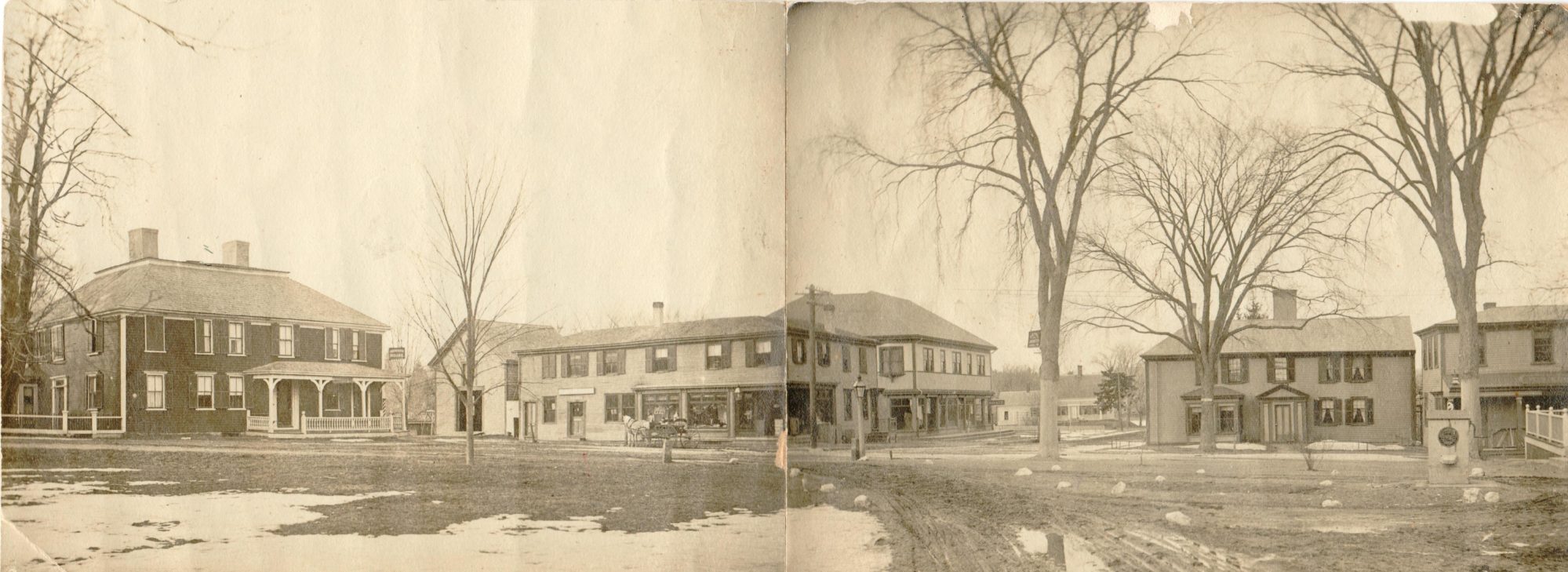
From the Hearth: Food in Hanover 200 Years Ago
Meet John and Mary, two young historians. They wanted to learn more about what was eaten in Hanover 200 years ago.
This is the hearth in the Historic Samuel Stetson House, one of Hanover’s oldest houses. A hearth is a very large fireplace where an open fire of burning wood provided heat for the house, and was used to cook all types of food. This hearth is where generations of the Stetson family prepared their meals by roasting and toasting, broiling or boiling, frying, baking, or grilling. Iron bars called cranes could hold pots over the fire while other iron bars called trammels could raise and lower the pots. Toasting racks, iron skillets, tin reflecting ovens, iron spits, and a whole variety of pans, kettles, and pots were used. Before the days of refrigeration, food was eaten fresh or preserved by pickling, smoking, drying, or salting. Milk spoiled quickly in hot weather, so it was made into cheese or butter. Most food eaten 200 years ago in Hanover was grown locally. But some food had to be imported, like oranges, lemons, pineapples, rice, sugar, olive oil, and spices like pepper and cinnamon.

Breakfast: Early Morning
People in Hanover got up early 200 years ago to take care of their animals—feeding, watering, and milking—like farmers everywhere. It was only after these chores were finished that they could eat breakfast. Children drew water from wells. This was boiled to make tea or coffee. Boiling water was added to grains to make gruel (a watery cereal) or to make a thicker, heavier porridge, like oatmeal. Johnnycakes were fried pancakes made from boiling water and cornmeal. These were very commonly served with butter or maple syrup in Springtime. Slices of bread were toasted in racks before the fire. Bacon was hand-sliced and fried in skillets. Butter was made from milk and had to be churned, a chore done by children. Butter was stored in ceramic crocks. Cheese was also made from milk and could be stored for months.
Mary and John tried oatmeal porridge, cornmeal johnnycakes, and apples with butter, cider, and tea for their Breakfast.

Dinner: Early Afternoon
Dinner in Hanover 200 years ago was the main meal of the day and eaten in the early afternoon. Food that had been cooking from early morning was served hot. Roasted chickens, thick stews, broiled fish, boiled vegetables with salted meats were cooked slowly over or in front of the hearth’s fire. Root vegetables included beets, parsnips, onions, and carrots. Baked beans were slowly cooked for hours in a rich brown sugar and molasses sauce. These were accompanied by puddings, custards, pies or tarts. Dried fruit like raisins or prunes would be served alongside small servings of spices like sugar, nutmeg, pepper, salt, and cinnamon. Many food items were only available seasonally like maple syrup and herrings (small fish) in the Spring, fresh vegetables like lettuce, cucumbers, and summer squash in the Summer, game birds in the Fall, and apples and pears for cider in the winter.
John liked the smoked pork shoulder and New England boiled dinner of corned beef, cabbage, carrots, beets, onions, and parsnips. Mary preferred the baked beans, raisins, and fruit turnover.

Supper: Early Evening
Supper in Hanover 200 years ago was smaller meal than today. Most often the leftovers from the earlier meal or food that took all day to prepare was eaten. Food for supper also depended on the time of year. Fish like herrings were common in the Spring, could be caught during the day and fried that night for supper. In the winter, meat and milk did not spoil as quickly, so they were consumed fresh. New foods were being introduced to Hanover 200 years. White potatoes were just becoming popular. And new methods for growing cranberries in bogs locally made the tart berries cheaper and more available. And in a few years, people would stop thinking tomatoes were poisonous and start eating them.
John and Mary had a supper of roast chicken, hard boiled eggs, cheese, and pickles, with salt. John and Mary had fun exploring the history of Hanover through food.

The Beehive Bread Oven
The open space in the back of the fireplace at the Hanover's historic Drummer Samuel Stetson House is a beehive bread oven. The term beehive is used because the space is like a traditional cone-shaped beehive. Hot burning embers and coals from the fire were placed inside to heat up the bricks. They were then brushed to one side. Bread dough was then placed on the hot bricks for baking. Once the bread was fully cooked, it was removed with a large wood or metal bread peel. Bread of 200 years ago was most often made from a mixture of cornmeal and rye which grew locally. White bread made from wheat was more expensive since it was shipped from other states. Bread was baked daily. Slices of bread could be toasted or dipped in butter and fried. Crusts were often so hard the bread needed to be soaked in water or milk and eaten as soft mush.
John and Mary decided that the bread oven at Stetson House worked just like a modern-day pizza oven.

